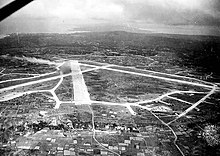| Marine Aircraft Group 31 | |
|---|---|
 MAG-31 Insignia MAG-31 Insignia | |
| Active | 1 February 1943 – present |
| Country | United States |
| Branch | United States Marine Corps |
| Type | Fixed Wing Aircraft Group |
| Role | Offensive Air Support Antiair Warfare Aerial Reconnaissance |
| Part of | 2nd Marine Aircraft Wing II Marine Expeditionary Force |
| Garrison/HQ | Marine Corps Air Station Beaufort |
| Motto(s) | "Going the Distance... Going for Speed!" |
| Engagements | World War II Battle of Okinawa Operation Desert Storm Operation Deny Flight Operation Enduring Freedom Operation Iraqi Freedom |
| Commanders | |
| Commanding Officer | Col Michael R. Cassidy |
Marine Aircraft Group 31 (MAG-31) is a United States Marine Corps aviation group based at Marine Corps Air Station Beaufort, South Carolina that is currently composed of two F/A-18C Hornet squadrons, one F/A-18A++ Hornet squadron, two F/A-18D Hornet squadrons, one F-35B Lightning II training squadron, one F-35C Lightning II squadron and an aviation logistics squadron. It falls under the command of the 2nd Marine Aircraft Wing.
Mission
Provide air support to Marine Air Ground Task Force commanders.
Subordinate units
F/A-18 Hornet Squadrons
- VMFA(AW)-224 "Bengals"
- VMFA-312 "Checkerboards"
F-35B Lightning II Training Squadron
Aviation Logistics Squadron
- MALS-31 "Stingers"
History
Marine Aircraft Group 31 was commissioned at Marine Corps Air Station Cherry Point, North Carolina, on 1 February 1943 under the command of Major Ralph K. Rottet. In September 1943, MAG-31 left the United States for Samoa where its squadrons would be stationed at numerous Samoan bases. During much of 1944 the squadron would fly neutralization missions against many of the Japanese garrisons that had been by-passed in the Marshall Islands such as Rabaul.
| MAG-31 (Battle of Okinawa) | |
|---|---|
| Components | Headquarters Squadron 31 Service Squadron 31 VMF-224 VMF-311 VMF-441 VMF(N)-542. |

During the Battle of Okinawa, MAG-31 came ashore on 7 April and began operating from Yontan Airfield on Okinawa. They were immediately able to put 80 out of 109 aircraft into the fight and maintained a combat air patrol from 1750 until dark to aid in the fight against the kamikaze attacks that were devastating the American Fleet. During the battle they also provided close air support for the Marines and Soldiers on the ground. While on Okinawa, MAG-31 was commanded by Colonel John C. Munn, who was later promoted to lieutenant general and served as the Assistant Commandant of the Marine Corps. The squadron stayed at Yontan Airfield until 1 July when they moved to Chimu Airfield further north on the island where they would stay until the end of the war. During their time on Okinawa the squadron also operated over Kyushu, the Chinese Coast, the East China Sea area and many places in between Formosa and Kyushu.
On 12 October 1945, Marine Aircraft Group 31 departed Okinawa for Yokosuka, Japan, becoming the first Marine land-based MAG to operate in the Japanese homeland. The MAG was transferred from the 2nd Marine Aircraft Wing to the 4th Marine Aircraft Wing on 12 February 1946, and then to the Fleet Marine Force Pacific 13 March 1946.
The group returned to the United States 5 July 1946 as a night fighter group,. and was stationed at Marine Corps Air Station Miramar, San Diego, California until it was decommissioned on May 31, 1947.
MAG-31 was reactivated March 17, 1952, at MCAS Cherry Point, North Carolina, and transferred to Marine Corps Air Station Miami, Florida, operating as a part of the 3rd Marine Aircraft Wing until it was again decommissioned on January 31, 1959.
On November 1, 1961, MAG-31 was again reactivated in a cadre status with six officers and 75 enlisted men to allow the new unit to properly form. The unit was based at Marine Corps Air Station Beaufort, South Carolina, as part of the 2nd Marine Aircraft Wing.
See also
- United States Marine Corps Aviation
- List of United States Marine Corps aircraft groups
- List of United States Marine Corps aircraft squadrons
Notes
- 3d MAW General Order 5-1943 - Commissioning Marine Aircraft Groups 31, 32, 33 & 34
- ^ Sherrod 1952, pp. 445.
- Sherrod 1952, pp. 372.
- Simmons 1974, pp. 181.
- Sherrod 1952, pp. 379.
- Sherrod 1952, pp. 398.
- Rottman 2002, pp. 436.
- "MAG-31 Lineage and Honors" (PDF). United States Marine Corps History Division. United States Marine Corps. Retrieved 23 November 2023.
- "United States Marine Corps Muster Rolls - 1959" (PDF). NARA. United States Marine Corps. p. 16. Retrieved 23 November 2023.
- "New Aircraft Group". Marine Corps Gazette. Quantico, VA: Marine Corps Association. December 1961. p. 63.
- "MAG-31 Activated". Windward Marine. Kaneohe Bay, Hawaii. 24 November 1961. p. 2. Retrieved 23 June 2024.
References
 This article incorporates public domain material from websites or documents of the United States Marine Corps.
This article incorporates public domain material from websites or documents of the United States Marine Corps.
- Bibliography
- Rottman, Gordon L. (2002). U.S. Marine Corps World War II Order of Battle – Ground and Air Units in the Pacific War, 1939 – 1945. Westport, CT: Greenwood Press. ISBN 0-313-31906-5.
- Sherrod, Robert (1952). History of Marine Corps Aviation in World War II. Washington, D.C.: Combat Forces Press. OCLC 1261876.
- Simmons, Edwin (1974). The United States Marines: A History. Annapolis, Maryland: Naval Institute Press. ISBN 1-55750-840-2.
- Web
| United States Marine Corps | |||||
|---|---|---|---|---|---|
| Leadership |
|  | |||
| Major commands | |||||
| Auxiliary | |||||
| Structure | |||||
| Personnel and training |
| ||||
| Uniforms and equipment | |||||
| History and traditions |
| ||||
| 2nd Marine Aircraft Wing | ||
|---|---|---|
| MAG-14 |  | |
| MAG-26 | ||
| MAG-29 | ||
| MAG-31 | ||
| MACG-28 | ||